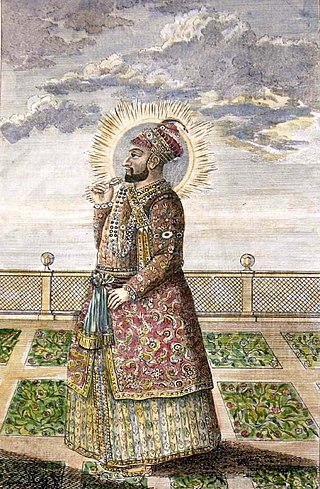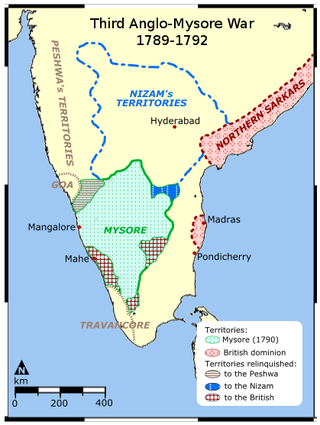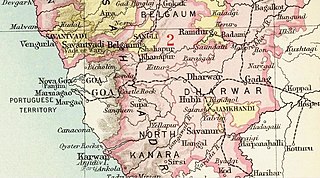
Tipu Sultan, commonly referred to as Sher-e-Mysore or "Tiger of Mysore", was the Indian Muslim ruler of the Kingdom of Mysore based in South India. He was a pioneer of rocket artillery. He expanded the iron-cased Mysorean rockets and commissioned the military manual Fathul Mujahidin. He deployed the rockets against advances of British forces and their allies during the Anglo-Mysore Wars, including the Battle of Pollilur and Siege of Srirangapatna.

Hyder Ali was the Sultan and de facto ruler of the Kingdom of Mysore in southern India. Born as Hyder Ali, he distinguished himself as a soldier, eventually drawing the attention of Mysore's rulers. Rising to the post of Dalavayi (commander-in-chief) to Krishnaraja Wodeyar II, he came to dominate the titular monarch and the Mysore government. He became the de facto ruler of Mysore as Sarvadhikari by 1761. During intermittent conflicts against the East India Company during the First and Second Anglo–Mysore Wars, Hyder Ali was the military leader.

The Maratha Confederacy, also referred to as the Maratha Empire or the Maratha Kingdom, was an early modern polity in the Indian subcontinent comprising the realms of the Peshwa and four major independent Maratha states who were often subordinate to the former. It was formed in 1674 with the coronation of Shivaji of the House of Bhonsle as the Chhatrapati of the Marathas. The Maratha realm was recognised by Bahadur Shah I, the Shahenshah of Hindustan as a tributary state in 1707 after a prolonged rebellion. The Marathas continued to recognise the Shahenshah as their nominal suzerain similar to other contemporary Indian entities.

The Kingdom of Mysore, briefly called the Sultanate of Mysore from 1761 to 1799, was a realm in the southern part of Deccan Plateau traditionally believed to have been founded in 1399 by two Hindu brothers, in the vicinity of the modern city of Mysore. From 1799 until 1950, it was a princely state, until 1947 in a subsidiary alliance with British India. The British took direct control over the princely state in 1831. Upon accession to the Dominion of India, it became Mysore State, later uniting with other Kannada speaking regions to form the state of Karnataka, with its ruler remaining as Rajapramukh until 1956, when he became the first governor of the reformed state.

The Second Anglo-Mysore War was a conflict between the Kingdom of Mysore and the British East India Company from 1780 to 1784. At the time, Mysore was a key French ally in India, and the conflict between Britain against the French and Dutch in the American Revolutionary War influenced Anglo-Mysorean hostilities in India. The great majority of soldiers on the company side were raised, trained, paid and commanded by the company, not the British government. However, the company's operations were also bolstered by Crown troops sent from Great Britain, and by troops from Hanover, which was also ruled by Great Britain's King George III.

The First Anglo-Mysore War (1767–1769) was a conflict in India between the Sultanate of Mysore and the East India Company. The war was instigated in part by the machinations of Asaf Jah II, the Nizam of Hyderabad, who sought to divert the company's resources from attempts to gain control over the Northern Circars.

The Anglo-Mysore Wars were a series of four wars fought during the last three decades of the 18th century between the Sultanate of Mysore on the one hand, and the British East India Company, Maratha Empire, Kingdom of Travancore, and the Kingdom of Hyderabad on the other. Hyder Ali and his succeeding son Tipu fought the wars on four fronts: with the British attacking from the west, south and east and the Nizam's forces attacking from the north. The fourth war resulted in the overthrow of the house of Hyder Ali and Tipu, and the dismantlement of Mysore to the benefit of the East India Company, which took control of much of the Indian subcontinent.

The Third Anglo-Mysore War (1790–1792) was a conflict in South India between the Kingdom of Mysore and the British East India Company, the Kingdom of Travancore, the Maratha Confederacy, and the Nizam of Hyderabad. It was the third of four Anglo-Mysore Wars.

The Fourth Anglo-Mysore War was a conflict in South India between the Kingdom of Mysore against the British East India Company and the Hyderabad Deccan in 1798–99.

A subsidiary alliance, in South Asian history, was a tributary alliance between an Indian state and a European East India Company.

The History of Karnataka goes back several millennia. Several great empires and dynasties have ruled over Karnataka and have contributed greatly to the history, culture and development of Karnataka as well as the entire Indian subcontinent. The Chindaka Nagas of central India Gangas, Rashtrakutas of Manyakheta, Chalukyas of Vengi, Yadava Dynasty of Devagiri were all of Kannada origin who later took to encouraging local languages.

Madhavrao II was the 12th Peshwa of the Maratha Empire in India, from his infancy. He was known as Sawai Madhav Rao or Madhav Rao Narayan. He was the posthumous son of Narayanrao Peshwa, murdered in 1773 on the orders of Raghunathrao. Madhavrao II was considered the legal heir, and was installed as Peshwa by the Treaty of Salbai in 1782 after First Anglo-Maratha War.

The political history of Mysore and Coorg (1761–1799) is the political history of the contiguous historical regions of Mysore State and Coorg province on the Deccan Plateau in west-central peninsular India from the time of the rise of Haidar Ali in 1761 to that of the death of his son Tipu Sultan in 1799.

Dhondia Wagh was a military soldier and adventurer in 18th century India. He started his career in the service of Hyder Ali, the ruler of Mysore. During the Third Anglo-Mysore War, he deserted Ali's successor Tipu Sultan, and subsequently raided territories on the Maratha-Mysore border. After the Marathas forced him to retreat, he sought refuge from Tipu and converted to Islam, changing his name to Malik Jahan Khan. After Tipu's death in the Fourth Anglo-Mysore War, he raised a force comprising soldiers from the former Mysore Army, and took control of northern part of the Mysore Kingdom. He styled himself as Ubhaya-Lokadheeshwara. The British East India Company as well as the Maratha Peshwa sent armies to check his rising power. He was ultimately defeated and killed by a British force led by Arthur Wellesley.
The Maratha–Mysore wars were a conflict in the 18th century India between the Maratha Confederacy and the Kingdom of Mysore. Though initial hostilities between the sides started in 1760s, the last battle began in February 1785 and ended in 1787.

Savanur State, Nawab of Savanur was one of the princely states in British India. The last ruler of the state acceded to the Dominion of India on 8 March 1948, becoming part of the Bombay State. Later in 1956, it transferred to Mysore State in what is now Karnataka.
The siege of Bahadur Benda occurred when the forces of Mysore led by Tipu Sultan besieged Bahadur fort in 1787. Tipu Sultan defeated the Maratha Army led by Hari Pant and captured the fort. It was the last military engagement between the Maratha Empire and Tipu Sultan.

The siege of Adoni was a military conflict that occurred between the forces of Tipu Sultan of the Kingdom of Mysore and the Maratha Confederacy allied with the Nizam of Hyderabad in 1786.

Haripant Phadke, known as Hari Pant was a general of the Maratha Confederacy. Hari Pant became a general during the siege of Badami on 20 May 1786 against the Kingdom of Mysore. He became general of 50,000 and won the war in Maratha-Mysore War.

The Battle of Moti Talab, which took place on March 5, 1771, was a significant engagement between the forces of Mysore, led by Hyder Ali(who was succeeded by his son Tipu Sultan after his death), and the Maratha army, commanded by Trimbak Rao. The battle resulted in a decisive victory for the Marathas


















